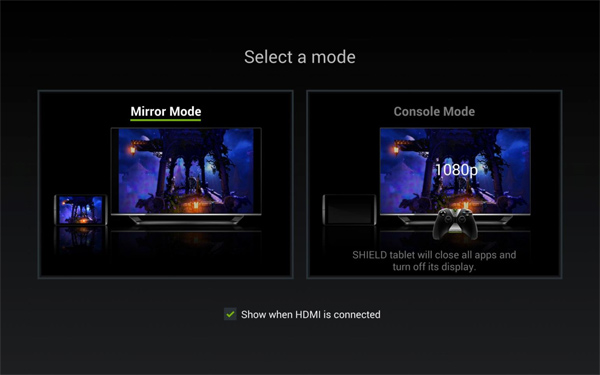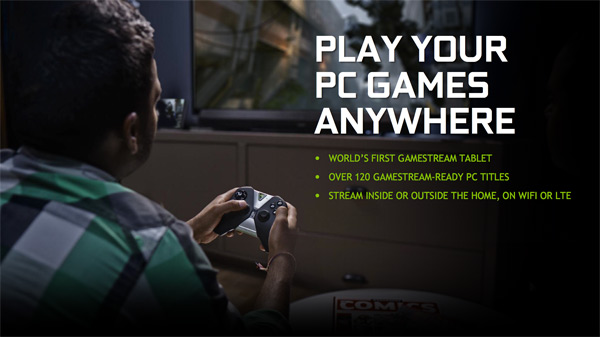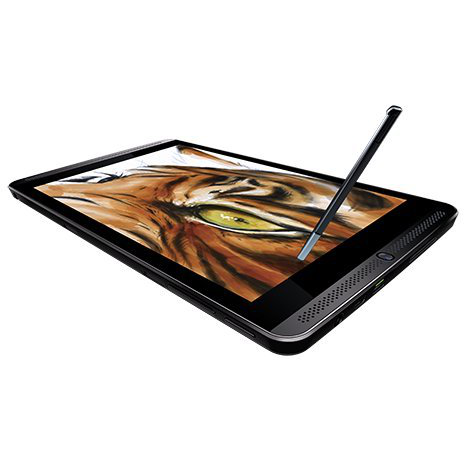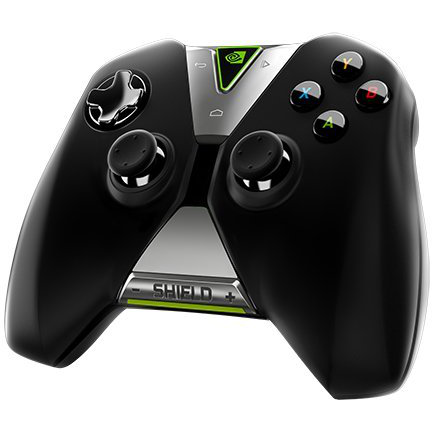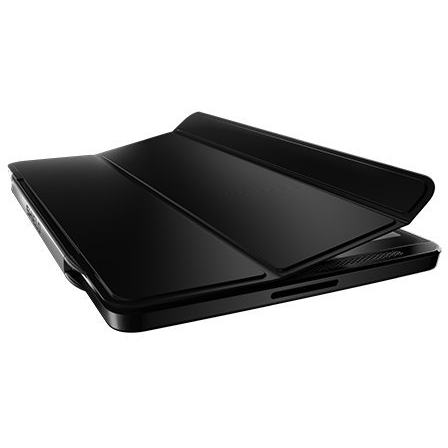Nvidia Shield Tablet And Shield Controller Review
The Shield Tablet, powered by Nvidia’s Tegra K1 SoC, deftly handles browsing and media playback duties. Combining it with the wireless Shield Controller transforms the 8-inch device into an exciting mobile gaming platform.
Console Mode And GameStream
Nvidia’s core strength is gaming and the Shield Tablet packs the necessary hardware to repel an alien invasion or horde of zombies, and enough games to keep the battle raging for hours.
The front-facing speakers get loud and remain distortion-free. However, the small drivers lack any real bass punch. At default settings, the sound is flat and tinny, particularly vocals on music tracks. But a few tweaks with the equalizer help the low- and mid-range frequencies sound a bit warmer. The stereo speakers do a nice job with positional audio cues while gaming.
Console Mode
Hooking the Shield Tablet up to an HDTV via mini-HDMI allows it to function like a game console, bringing Android and PC games to the big screen with support for up to four wireless Shield Controllers.
In Console Mode, the Shield Tablet becomes a conduit between content and the TV, not just for games, but for videos and music as well. The source could be the local microSD card; streaming services like Netflix (including full 1080p support), Hulu, YouTube, or Pandora; or your own media server with the help of a third-party app.
There are two different options for displaying content on the TV. In Mirror mode, the tablet display remains active and is mirrored on the TV. Since there’s a resolution mismatch between the tablet’s display (1920x1200) and the TV (1920x1080), some content will be letterboxed. This isn’t always true for video streams, however, because they are sent to the TV at the encoded resolution.
The second option is Console mode, which turns off the tablet’s display and does away with letterboxing by changing the native resolution on the tablet to 1920x1080 to match the TV. Switching to this mode closes all open applications and reboots the tablet.
GameStream
GameStream is the key to playing your PC games in bed, the backyard, or even down the street at the coffee shop. A proprietary technology, GameStream utilizes a GeForce GTX 650 or better graphics card (Kepler-based GTX 600M or higher mobile GPU) to render the game on the PC with the NVEnc hardware-based encoder. The resulting H.264 video stream is then sent over Wi-Fi or the Internet to a Shield Portable or Shield Tablet, which uses its Nvidia GPU’s PureVideo HD feature for decoding the stream. GameStream supports 720p video over wireless connections and 1080p over Ethernet using an optional Ethernet-to-USB adapter at up to 60 frames per second.
Get Tom's Hardware's best news and in-depth reviews, straight to your inbox.
In addition to the GPU requirements, GameStream requires the GeForce Experience application and Nvidia's latest drivers on a PC running Windows 7 or newer. For streaming over Wi-Fi, Nvidia recommends at least an 802.11a/g router, but preferably an 802.11n dual-band router. Streaming PC games over the Internet calls for a minimum symmetric bandwidth of 5Mb/s. In the article Shield Remote GameStream: How Far Will You Go to Game?, we examine how well GameStream works over several different connections using the Shield Portable.
Playing PC games on a tablet from nearly anywhere you want is certainly cool, but not flawless. I found the games I purchased through Steam to work best, while some of my older titles on DVD had issues. First, most games on optical disc require it physically present to play. Launching a game on the Shield and then running downstairs to pop a disc into your drive breaks the mood. The second issue involves game controller support, or rather a lack thereof. Even though Nvidia lists support for BioShock 2, my version on DVD wouldn’t recognize the Shield Controller, nor was there any way to enable support from within the options menu.
BioShock Infinite and Fallout 3, both purchased through Steam, worked well and even referenced the controller inputs rather than keyboard/mouse commands in the on-screen instructions. Portal 2 also worked after manually enabling controller support from within the game.
After seeing how well GameStream worked with some of my Steam games, I decided to push the compatibility boundary by breaking out some really old games. Since Star Wars: The Force Unleashed is a console port, I thought it might work. However, it didn’t recognize the controller and rendered at the wrong resolution in a tiny window. It’s not a very good game anyway, so no big loss. Next, I tried The Chronicles of Riddick: Escape from Butcher Bay, one of the better film adaptations in my opinion. But it didn’t recognize the controller inputs either. The lesson here is to ditch the DVDs and stick with Nvidia’s list of compatible GameStream games for best results.
Not wanting to concede defeat, I paired a Bluetooth keyboard and mouse with the Shield Tablet and fired up GameStream again (I’m way better with a mouse than a thumbstick anyway) and was pleasantly surprised. Not only did the officially supported games work with no discernible input lag, but the older, unsupported games like Chronicles of Riddick and my DVD version of BioShock 2 worked as well.
Other than some compatibility issues with older games, GameStream works and is a great way to extend PC gaming beyond a desk and even to an HDTV when used in conjunction with Console Mode. Using an Asus RT-AC66U 802.11ac dual-band router and a GeForce GTX 760 in my PC, frame rates remained fluid and there wasn’t any input lag. One quirk I noticed is that exiting the game to the Android home screen or back to the Shield Hub app doesn’t automatically pause the game. The game is still running live on the PC with your character standing in place like an idiot while getting shot. To keep this from happening, it’s necessary to pause the game first by using the correct button on the Shield Controller before exiting.
Nvidia isn’t the only company to recognize the benefit of remote rendering and streaming PC games. Valve offers a similar service with Steam In-Home Streaming. It works in a very similar way to GameStream, rendering games on a PC and streaming an H.264 video stream to a client on the same network. Unlike GameStream, the Steam solution is GPU agnostic and works with Windows, OS X and Linux. However, it doesn’t work with tablets, instead requiring another PC or laptop as the client.
Current page: Console Mode And GameStream
Prev Page Stylus And Inking Next Page Grid, ShadowPlay And Twitch-
blubbey Those GPGPU benchmarks are ridiculous in comparison. It looks like a great bit of kit from what I've seen so far. A die shrunk Maxwell should be fantastic. Maybe even a lower clocked version just for power consumption? It'll still perform as well, if not better than the K1 at 750MHz (assuming 2 SMMs) I'd assume.Reply -
Memnarchon "Based on these results, Tegra K1 must be “a neural net processor; a learning computer” sent back through time to destroy all of the other SoCs that could lead a rebellion in the post-apocalyptic future."Reply
Lol this is epic! xD
Anyway, great and unique review. Especially for the so many GPGPU benchmarks.
Nvidia tablet at $299 seems to be a great buy. -
aberkae If maxwell brings double the performance per watt on the same node the next tegra chip on 20 nm node should be a home run for the companyReply -
deftonian Impressive, but I feel it's still missing that "umph" to get me to buy this and carry it around as an added device, next to my phone (Note 3). Maybe I just don't game enough on the android market or steam. Either way, I think it is impressive for a mobile gaming device and all the things it offers. I think they've started a great line and hope it grows into a successful tablet/gaming brand.Reply -
aberkae If maxwell brings double the performance per watt on the same node the next tegra chip on 20 nm node should be a home run for the companyReply -
gio2vanni86 The streaming a game while i'm at my friends house using my PC at home is what has me very interested. Plug into his TV and play amazing games he can only dream of. I'm in.Reply -
vithrell Just wait for Intel's Core M. It wont match the price (CPU alone will cost $300), but in fanless tablet form factor it wont have worthy competitor. Early GPU benchmarks give Core M 55k graphics score in Ice Storm, so more than 1.5x more power than Tegra K1. AND you can run full Windows on it. I wish Nvidia took x86 path with its cpu cores.Reply
